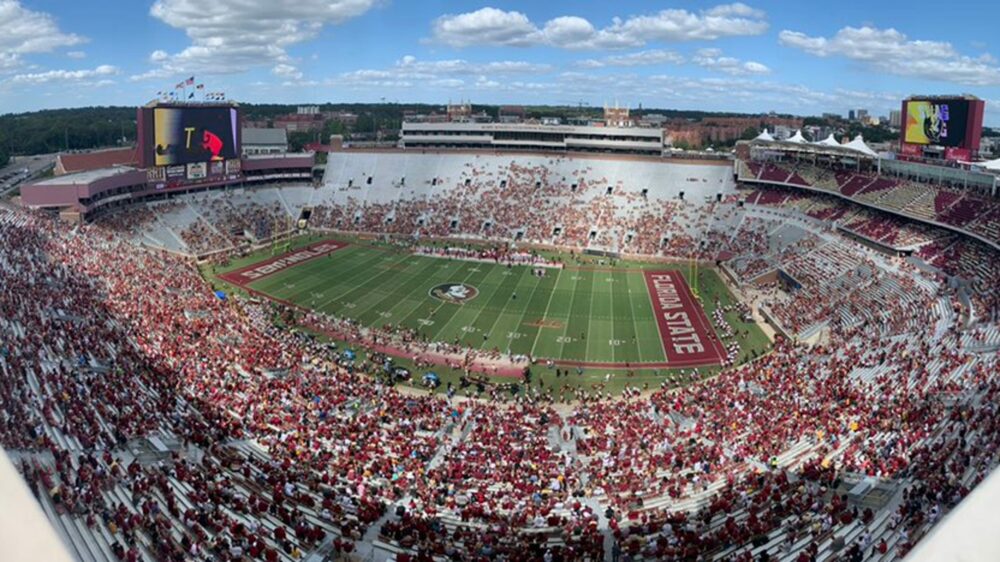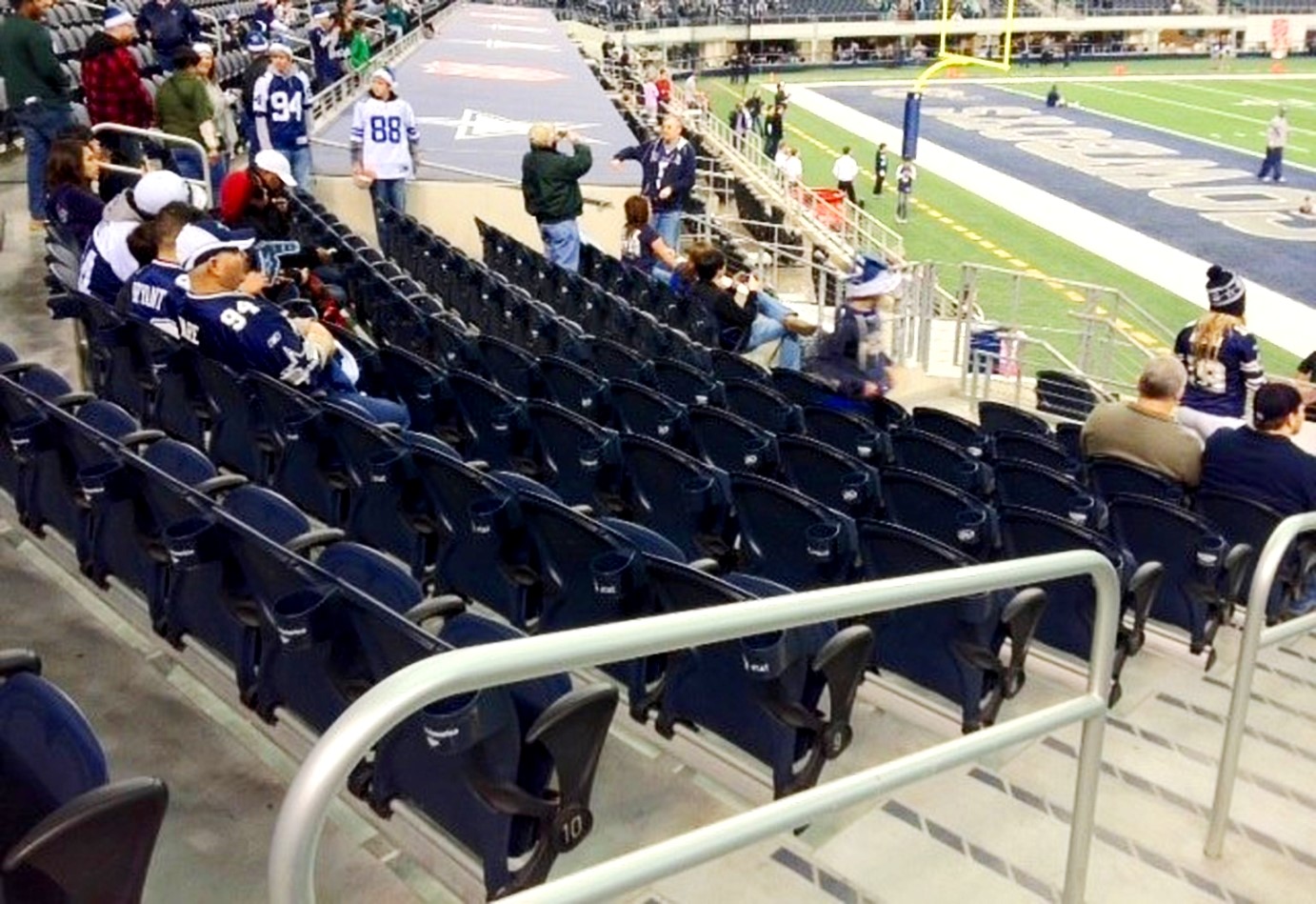As humans, and as Americans, we are accustomed to believing that bigger is better. Take for example, car manufacturers like General Motors and Ford who are quickly approaching 90% of their sales in either SUV’s or trucks. At least in the auto industry bigger can be spun as safer but it’s also more about the appearance of being cool. A Ford F-150 is a lot cooler than a Ford Focus.
For decades in college football larger football stadiums were an opportunity to increase revenue of course but also a symbol of power and prestige. If Bobby Bowden once said a football program is the front porch of a university then for years the football stadiums were supposed to be grand wrap around porches with wonderful views and ample space for rabid fans.
However, in recent years the mammoth seating capacity stadiums have come under scrutiny as ticket prices, and above all else the value of home entertainment, outpaces the value of watching games live on campus. Suddenly, it’s become far less cool to brag about game attendance.
This is a very recent phenomenon. Back when the Crossroads Project was announced by Notre Dame there were still calls among fans to increase the stadium capacity to well over 100,000 seats for reasons unexplained besides the ability to brag to friends about a larger and perhaps more intimidating crowd.
Of course, Notre Dame decided to smartly move in the other direction by reducing capacity from 80,795 to 77,622 once the project was complete in 2017. Not only was space on a small campus in a smaller town a huge issue but nothing about the future of football demands an even larger seating capacity.
***
Recently, Florida State football was in the news for their lowest attendance in 36 years back on September 21st when only 46,530 fans showed up in a win over Louisville. That’s just over 58% capacity at Doak Campbell Stadium in Tallahassee. Now, a lot of that has to do with the Seminoles’ recent struggles on the field as low attendance for poor performance isn’t a new revelation.
Yet, it would seem obvious that for the vast majority of college football programs their stadiums are far too large. Even during FSU’s National Championship 2013 season they set their all-time attendance record (84,409) against Miami, but didn’t sell out 5 other home games, leaving upwards of 34,000 seats unsold.
In a twist, the exceptions are the largest college football stadiums in the country. Among the 8 programs with 100,000+ capacity there really aren’t any current attendance woes, including Tennessee which god bless them still gets close to 90% capacity for most games.
For the vast majority of the country, chances are your football stadium capacity is way too damn big.
A perfect example of this is Louisiana who built their Cajun Field in 1971 with 26,000 seats, added 5,000 seats a couple decades later, then added over 10,000 more seats in 2014. They’ve sold out the current stadium once and totaled over 30,000 fans for a home game on only 7 other occasions in the history of their program.
By my estimate, had Louisiana kept their original 26,000 seat stadium they would have missed out on roughly $3.5 million in ticket sales over the years using current average prices from StubHub. However, their 2014 renovation cost the school $24 million, and unbelievably enough, Louisiana is still weighing another renovation project that could cost upwards of $65 million and push seating up to 65,000 seats.
In what world does it make sense for a Sun Belt program to have a larger stadium than the Chicago Bears?
***
For those who were proponents of Notre Dame’s massive Crossroads Project a big selling point was the increased mixed use capabilities and emphasis on academic/student facilities now surrounding the university’s nearly 90-year old stadium.
While we aren’t likely to see the Fighting Irish football field converted into a lawn as part of an evolving academic quad any time soon, the mixed use capabilities seem to be going well. The NHL Winter Classic between Chicago and Boston, college hockey between Notre Dame and Michigan, a pair of international rugby games, a friendly between Liverpool and Dortmund, a Garth Brooks concert, plus the recently announced 2020 summer Billy Joel concert have offered a lot more options for a small-town college campus 90 minutes from Chicago. Also, smaller things like “Flick on the Field” are a nice addition for students, as well.
The more interesting vision for the future is what is going to happen during college football games inside the stadium.
Years ago, I argued that Notre Dame Stadium desperately needed to begin the modernization process because the times were changing so fast that it would be dangerous to put the program in a position where game day was 25 years behind but felt more like it was 80 years behind the times.
In the past, Notre Dame appeared to operate based on a system of slow-moving upgrades, meaning if the concourse food was changed it wouldn’t need to be addressed again for a really long time. Notre Dame was always slow to modernize while also being slow to revisit upgrades from the past.
I know for some a video board, ribbon board, field turf, box suites, and smoke-filled entrances made Notre Dame Stadium become modern but the truth is over the next 15 to 20 years we are likely to see even more grandiose and drastic changes to the way fans consume football inside the stadium that the Crossroads upgrades will feel stale sooner rather than later.
Recently, Scott Hines at SB Nation wrote a lengthy piece about the future of the American ballpark which includes a bunch of interesting and thought-provoking changes that could be made to Major League Baseball homes. While some of that may be decades away from being built by any club it does make me think about two movements that will be linked together in the future:
Smaller is better inside the stadium and more integration is better outside the stadium.
The latter is where Notre Dame’s Crossroads hit a home run. It recast the football stadium as a center of use on campus that goes well beyond half a dozen Saturday’s each year. On the inside of the stadium I’d bet that by the time I’m an old man (let’s say 2050) the capacity will be close to the original 52,000 from 1930, and perhaps even smaller.
We’ve already watched suites try and mimic the experience of the American living room and in the future that will be extended further to other areas of the bowl seating. The experience in the future is something we can only imagine today. Plush wide seating areas, couches even? Personal interactive video screens for each seat? Virtual reality replays? Entire sections converted into lounges? Fantastic temperature controlled areas with head covering? Food delivery on a level that seems impossible now? Some of this is already happening in stadiums across America but it will be widespread in a couple decades.
The biggest game changer may be seating amenities so impressive that fans will move portions of their tailgating inside the stadium before and after football games–especially once live betting becomes commonplace. Imagine Notre Dame showing 10 different noon football games while you lounge inside your stadium seat. The most mind-blowing thing may be packing fans into Notre Dame Stadium when the Irish are on the road with the game 3D-projected onto the field in South Bend like the players are in front of the home crowd. This is the future.
But, wait!
How could a school like Louisiana keep up with all of this fan technology and fancy gadgets at the finger tips of fans? First, are we even sure these smaller schools are going to survive at the scholarship FBS level for another 30 or 40 years? It’s possible the growing catering to fans’ entertainment whims prices out many schools in a way that can’t be fought off from athletic departments in the red (for the record, Louisiana made $82,086 off their football team according to the most recent estimates).
Secondly, if these small schools do survive their stadiums might be seating about 8,000 people in total. Is it worth it to spend $65 million to create empty concrete seats that will never be used or is it wiser to spend $15 million adding $2,000 worth of technology and perks for every fan to come watch live football if you really want to create an incentive for people actually showing up?





I like your suggestion that the first thing ND probably needs to address are the actual SEATS. I understand the nostalgia of seeing wooden benches all over the place, but they are absolutely miserable and unecessarily so. When it snows or rains, that wood just gets soaked up and you cant sit down(which actually is a good thing, but come on). I dont know that we need something like baseball parks have with plush leather seating with TV screens, but something like this is a must-have:

I thought new bleachers were a part of the Crossroads project? Still not seats, but they also aren’t wood anymore. (FWIW, I haven’t been since the Crossroads project)
That is correct.
The old gold seats (now blue) are still in place with backs and the rest of the bowl (outside of the suites) are vinyl-covered benches. The bucket seats will come in due time.
You have to maintain benches for the student section. Rest of the stadium could definitely become seats. I think they like having the fewer actual seats right now, it creates an extra level of ELITENESS.
Guess I missed that last year. I’ve only been to one game since CC and thought they were still wood. Either way, benches still pool water and are uncomfortable as hell. Seats also have the benefit of spreading the crowd out and giving everyone some elbow room. We need these creature comforts
Pat Fitzgerald’s TL;dr – Cell phones & millennials.
I take a somewhat opposite view. People don’t go because prices are too high. My grandparents had box seats right next to Fr. Joyce since the time the stadium was built until they died in the ”late ;60s. Then my dad, and 2 uncles, their wives and usually a guest couple had the seats until 1999. My dad got tired of paying a “donation”and then the price of the tickets to boot so they quit going to the games. Make the tickets affordable so the average person can go and people don’t have to take out a second mortgage on their houses. Our family is a large extended family with 41 grandchildren and umpteen great grandchildren along with 29 ND graduates in the extended family. Most are strong ND fans but are not fond of ND’s money grubbing ways.
If we’re speaking specifically about Notre Dame, I’m not sure prices are much of an issue. The stadium is still full and quite frankly there are a lot of wealthy people attending games.
I think it’s an issue for other programs but it’s not a major factor. Many of the smaller programs–like UB near my home–literally cannot give tickets away for free.
If they’re going to make the experience more like being in my living room, then I might as well just stay in my living room.
The problem is that today the experience in your living room is better than being in the stadium.
For the future it may be the experience in the stadium–offering comforts, amenities, and technology unavailable in your home–will become better than your living room.
You’ll never feel the roar of the crowd, the atmosphere, nor the tension or elation that comes with being at a live sporting event. That’s why I go to games, not to have the same camera angles and exact same experience as at home. But it SHOULD be comfortable to do so.
As a 30 year old male w/o kids in Chicago I go to a good amount of sporting events. I think the biggest change in getting people back into the stadiums is going to be the matchups. Matchups get people excited and get people to campus even when they don’t have a ticket.
There’s always going to be economic factors at play, but if people really want to do something they’ll find the money. You mean to tell me the guy who is gambling on games can’t put that money he will probably lose over the course of the season towards taking his kids to a game. This applies more to football since they only have 6-8 games that they have to sell.
I think we’re going to see a move away from the conference model and back to more independence at least for football. These top programs (Texas,OU, Bama, LSU, USC, Clemson, UM, OSU, Penn St) are going to get sick of having to share their money with the stragglers. I don’t think this is happening in the next 10 years, but my 2050. People assume that the tv contracts are going to just keep growing, but that will stop eventually.
The schools need people on campus. The amount of money that a home game generates for ND and SB is huge. Look at hotel prices for UGA 2 years ago versus this year with no marquee home matchup.
Side note – love your idea of the game being projected on the field. I think the NBA should move to a NBA Jam hot spots projected onto the floor and you have spots that are worth 10, 6, 8 points and they move around each possession. Imagine the gambling on that!
If NBA is doing the Jam thing, can we please dump lighter fluid on the ball and light it up after 3 consecutive buckets?
Sadly I won’t be around in 2050, but if I’m lucky i’ll be looking down to see if the predictions come true.
When I was inCleveland as a kid, the original baseball stadium had a huge outfield. 500+feet to center field and much longer down the lines than any park today. In the late 50’s or early 60s they put a chain fence up that greatly reduced the outfield. After that, Several times during the season they’d have family night where people could picnic before the game in the space between the original wall and the new fence, so who knows, tailgating inside the stadium could come to pass.
As for watching the game, there is no better way to watch than at home on my 75 inch tv, with it being recorded, so I can replay whatever I want to see immediately whether the broadcasters do or not, stop action to go to the head or get something to eat, in my comfortable easy chair, no weather issues, no parking hassles, nobody obstructing my view. I miss the atmosphere in the stadium, but not enough to physically go to the game.
By the way, by “UB” do you mean Buffalo, Eric?
Yup!
“When I was inCleveland as a kid, the original baseball stadium had a huge outfield. 500+feet to center field and much longer down the lines than any park today. In the late 50’s or early 60s they put a chain fence up that greatly reduced the outfield. After that, Several times during the season they’d have family night where people could picnic before the game in the space between the original wall and the new fence…”
You’re directionally right about this, but here’re the specifics. The original baseball dimensions of Municipal Stadium (originally Lakefront Stadium) were 463′ to dead center and 322′ down the lines. So, a much deeper CF but roughly the equivalent down the lines as we have in parks today (while, say, Cambden Yards is a band box, Busch Stadium is 400′ in center and 335′ down the lines). Starting in 1947, centerfield was moved in to 410′ and the lines to 321′. This created an area between the bleachers and the fence that was sold as standing room. That was basically the end zone and goal line area in the stadium’s football configuration.
I think CF came in a little further sometime after that, to like 400′, except for one season in the early ’90s when the fence was moved back to 410′ because (a) the Tribe lineup had no power so hitting the ball even 400′ was extremely unlikely; and (2) Tribe brass wanted to let banjo-hitting speed merchant Alex Cole roam the cavernous outfield, robbing opposing hitters of XBH. Like so many of the Tribe’s plans during that era, it didn’t work out so well.
Thanks, I stand corrected👍
Not at all. Whose memory is perfect? Plus, as the owner of (no joke) at least 50 Alex Cole rookie cards, I never pass up the chance to talk about him.
Look, I can either go sit in the stadium and freeze, or stay at home and watch through cranial implant VR on my hoverchair, while the robot butler serves me Popplers and Pan Galactic Gargle Blasters.
Also Cheez-Its.
My inner curmudgeon hates these potential technological changes and wants to go back to freezing my ass off on wooden benches like god intended. Harrumph!
It’s kinda like preferring to camp out instead of staying at a hotel. My first ND game was an early Nov. game vs. Navy on a cold, wet day. Making it through that day with 60,000 other ND fans and I couldn’t wait to go to my next ND game. I don’t want all the comforts of home. Give me a good seat, food and some beverages before and after and I’m good.
50 years from now they can have a throwback section where you’re squeezed in between really large people, water thrown on you, and punched in the face.